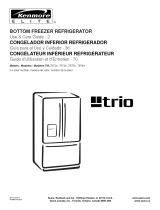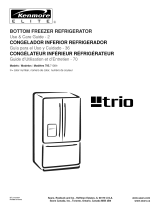
5
REFRIGERATOR INSTALLATION
WARNING
EXCESSIVE WEIGHT HAZARD
Use the assistance of two or more persons to move or
install the refrigerator. Not following these instructions
may cause injury to the back and other parts of the
body.
UNPACKING
“This appliance is intended to be used in household and
similar applications such as:
-Staff kitchen areas in shops, offices and other working
environments; farms houses and by clients in hotel, mo-
tels and others residential type environments.
-Bed and breakfast type environments; catering and si-
milar non-retail applications.”
To remove adhesive tape residue, rub it well with your
fingers and a little liquid detergent. Clean with warm
water and let dry.
Do not use sharp instruments, rubbing alcohol, flammable
liquids or abrasive cleaning products to remove the
adhesive
tape or glue. These products can damage the
surface of your refrigerator. For more information, see
the section on “Important Safety Instructions”.
The shelves come already installed in their factory
position. Remove the shelves and replace them
acc
ording to your spacing needs.
Moving Your Refrigerator:
Your refrigerator is extremely heavy. Make sure you
protect the floor when moving your refrigerator for
cleaning or servicing. Always pull your refrigerator
straight out when moving it. Do not shift from side
to side or “walk” the refrigerator when attempting to
move it as this can cause damage to the floor.
WARNING
EXPLOSION HAZARD
Keep all flammable materials and vapors (such as
gasoline) away from the refrigerator. Not following
these instructions may cause death, explosion or fire.
INSTALLATION
1. Avoid placing the unit near heat sources, direct
sunlight, or humidity.
2. To avoid vibration, the unit should be leveled. If needed,
adjust the leveling screws to compensate for an
unleveled floor. The front should be slightly taller than
the rear to ensure that the doors close properly. The
leveling screws can easily be turned by slightly tilting
the front of the refrigerator, turning the leveling screws
clockwise (
) to raise it and counter-clockwise
(
) to lower it.
3. Install the refrigerator in an area between 55 °F
(13 °C) and 110 °F (43 °C). If the surrounding temperature
is lower or higher than previously mentioned, it can
adversely affect the unit.
CAUTION: Avoid placing the unit near heat
sources, direct sunlight or humidity.
ONCE INSTALLED
1. Carefully clean your refrigerator and remove and dust
accumulated during shipping.
2. Install accessories such as the ice bin, door racks,
shelves, etc., in their proper places. These are already
packed to prevent any possible damage during
shipping.
3. Leave your refrigerator on for 2 to 3 hours before
storing food inside. Verify that there is a flow of cold air
in the freezer compartment to ensure proper cooling.
Your refrigerator is now re
ady for use.
WARNING:
ţTake care when working with the hinges, base cover
and stops, etc. You may injure yourself.
ţDO not place your hands or any tools in the air vents,
the base cover or in the bottom of the refrigerator. This
may cause injury or electrical shock.
Keep a Proper Distance from Adjacent
Flooring
To avoid noise and vibration, the unit must be leveled and
installed on a solidly constructed floor. If required, adjust
the leveling legs to compensate for unevenness of the
floor. The front should be slightly higher than the rear to
aid in door closing. Leveling legs can be turned easily by
tipping the cabinet slightly. Turn the leveling legs to the
left to raise the unit or to the right to lower it. (See Leveling
and Door Alignment.)
Objects
Please keep the refrigerator at an adequate
distance from other objects. Insufficient
spacing can reduce the refrigerator’s
freezing efficiency and increase electricity
consumption.
(5.08 cm) 2”
Before installing your refrigerator, remove any tape or
temporary stickers. Please remove vinyl from doors
before connecting unit to the electrical supply (on some
models). Do not remove any stickers that feature
warnings, the model serial number or the technical label
of the product located on the back of the refrigerator.


























